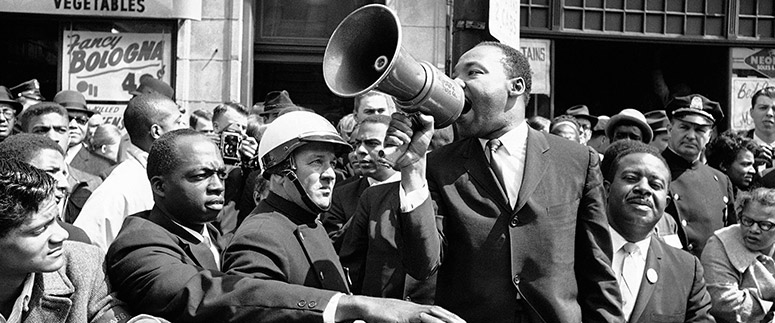THE NATION CLASSROOM
History as It Happened
RACE RELATIONS and CIVIL RIGHTS
MODULE SIX: 1945-1965
PERIOD SUMMARY: In the years after World War II, African-Americans’ battle for civil rights increasingly took center stage in American life. Highlights of that period include Brown v. Board of Education (the unanimous 1954 decision by the US Supreme Court that found “separate but equal” schools were unconstitutional); local boycotts of segregated buses in many cities, including Montgomery and Birmingham, Alabama; bus trips made by trained volunteers (“freedom riders”) to southern states, challenging segregation in public places; the 1963 March on Washington for Jobs and Freedom (site of the “I Have a Dream” speech by Dr. Martin Luther King Jr.); Fannie Lou Hamer’s founding of the Freedom Democratic Party, which she represented at the 1964 Democratic National Convention, and the passage of critical federal legislation, most notably the Civil Rights Act of 1964 and the Voting Rights Act of 1965.
The murders of civil rights workers James Chaney, Andrew Goodman, and Michael Schwerner in Neshoba County, Mississippi in June 1964 sparked national outrage and an extensive federal investigation.
Below you’ll find excerpts from selected articles that ran in The Nation in the 1950s and 1960s about the civil-rights movement.
The DBQ (document-based question) about this set of excerpts is: Was the overall strategy of the civil-rights movement in the 1950s and early 1960s successful? Describe at least four tactics that civil-rights leaders deployed during the period and evaluate their contributions to the movement’s effectiveness.
AS YOU READ: Things to Look For
- Review the dates of publication of each of the seven documents, all of them excerpts from The Nation. Why is it important that the first document is dated 1952, and the second document dated 1955? How are the dates of other articles important?
- Identify types of action taken by civil-rights advocates in each document. How many involved bringing court cases? Nonviolent direct action? Political organizing? Civil disobedience? Which appear to have been most successful?
- Two of the documents refer to the same idea about litigation. One notes “a century of litigation”; the other refers to “One hundred years.” What is the meaning of that phrase? How did civil-rights organizers attempt to counter it?
- Numerous examples of “unequal justice” are mentioned. Identify each as you read the excerpts.
VOCABULARY
direct action
due process
freedom riders
NAACP


